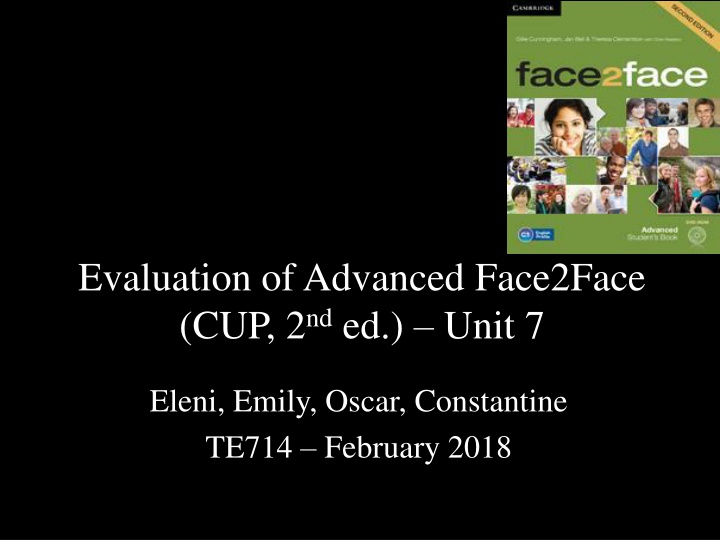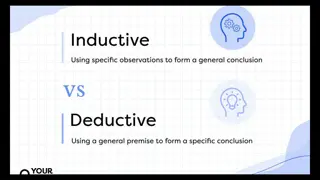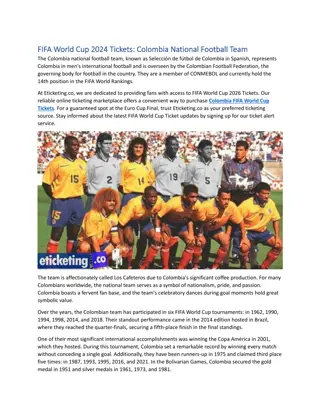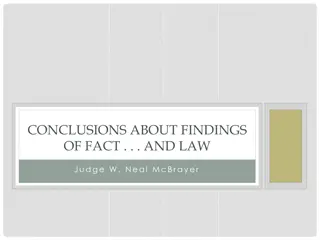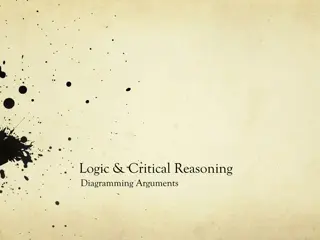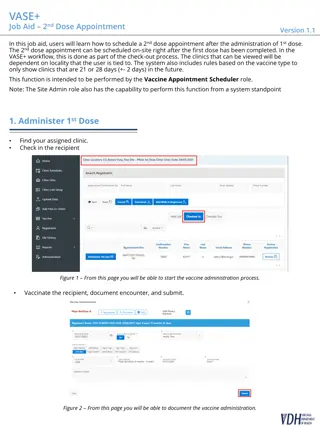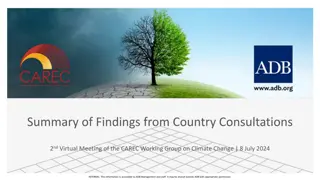Evaluation of Advanced Face2Face (CUP, 2nd ed.): Unit 7 Findings and Conclusions
Evaluation of Unit 7 in the Advanced Face2Face coursebook involves assessing various aspects such as design, content, practice, and methodology using impressionistic criteria. Teachers Eleni, Emily, Oscar, and Constantine individually evaluated the unit based on their impressions. The evaluation highlighted strengths and areas for improvement, including the presence of communicative approaches, lexical and deductive methods, and suitability for adult learners. The findings indicate varied perspectives on the effectiveness of the material and teaching methods.
Download Presentation

Please find below an Image/Link to download the presentation.
The content on the website is provided AS IS for your information and personal use only. It may not be sold, licensed, or shared on other websites without obtaining consent from the author.If you encounter any issues during the download, it is possible that the publisher has removed the file from their server.
You are allowed to download the files provided on this website for personal or commercial use, subject to the condition that they are used lawfully. All files are the property of their respective owners.
The content on the website is provided AS IS for your information and personal use only. It may not be sold, licensed, or shared on other websites without obtaining consent from the author.
E N D
Presentation Transcript
Evaluation of Advanced Face2Face (CUP, 2nded.) Unit 7 Eleni, Emily, Oscar, Constantine TE714 February 2018
Approaches to evaluation Impressionistic Authors / Publisher s MS CEFR C1 can-do Own criteria
Own evaluation criteria Impressionistic In depth Flick test 8 aspects 8 statements 5-score Likert Scale (strongly disagree disagree neither agree nor disagree agree strongly disagree) Total score Layout and Design 20 Context & Content Methodology criteria Practice Mean scores Total score out of 20: equal weighting
Authors/Publishers MS CLAIMS FINDINGS For adults and young adults Crime relevant to target audience Communicative approach ? Deductive approach Lexical approach (e.g. collocations, p. 70) Consciousness raising / Noticing Combination of current methodology Easier learning and teaching ? Easy learning ? TB: quick review, preview, extra ideas Equal importance to V and GR V: 14 tasks GR: 6 tasks Focus on L and S in social situations ? Social situations Intonation for speaking Reading Vocabulary ? GR ? Not enough practice Teachable units with minimal prep
CEFR C1 Can-do statements Can range of demanding, longer texts and recognise implicit meaning Can use language flexibly and effectively for social, academic and professional purposes Can produce clear, well- structured, detailed text on complex subjects, showing controlled organisational connectors devices Texts long and dense enough ? No checking of implicit meaning understand a wide Discursive essay (W, p. 73) Peer communication Connecting words (Writing, p. 73) Cohesive devices: Synonyms (p. 66, 1d) use of patterns, cohesive and
Own evaluation Pre-use Teacher Impressionistic (40) Design/ Layout (5) Content/ Context (5) Practice (5) Methodology (5) Eleni 25 2.5 3.5 3.5 3.5 Emily 25 1 3.25 3.33 2.5 Oscar 26 2.5 3.4 3.8 3 Constantine 28 2.5 3.5 4.33 2.75 Mean scores: 26 2.125 3.4125 3.74 2.9375
Cumulative per category (4 teachers) Mean per teacher
Conclusions Pros Cons CEFR can-do statements fulfilled Typical textbook (skills & systems) Supports novice and experienced Ts Communicative approach not consistently present or sufficient Not easily adaptable tasks Non-inspiring, non- controversial topics
